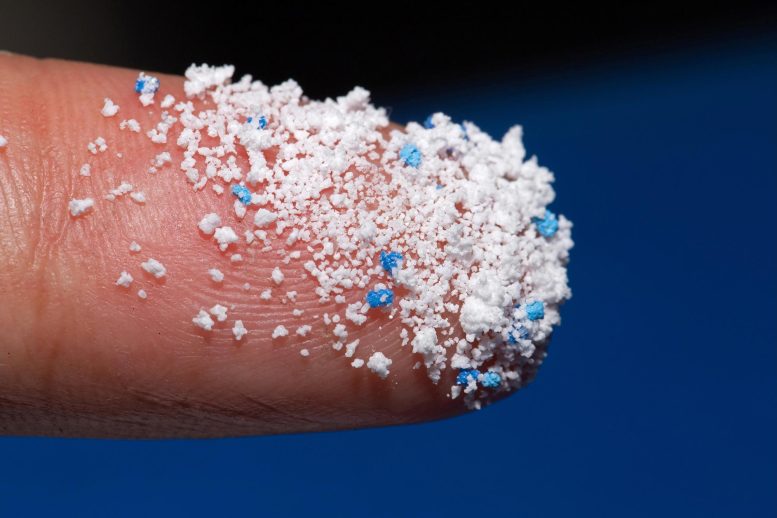
New research has found that exposure to microplastics led to behavioral changes and immune alterations in mice, particularly older ones. The study discovered that microplastics accumulated in multiple tissues, including the brain, and may contribute to conditions similar to dementia.
The study indicates a potential risk for serious health consequences, such as Alzheimer’s disease.
Microplastics, a highly prevalent form of plastic pollution, have infiltrated air, water, and food chains globally. Despite the widespread acknowledgment of their adverse effects on the environment and marine life, there has been a lack of research on their potential health consequences for mammals. This gap in knowledge led Jaime Ross, a professor at the University of Rhode Island, to initiate a new study.
Ross and her team focused on neurobehavioral effects and inflammatory response to exposure to microplastics, as well as the accumulation of microplastics in tissues, including the brain. They have found that the infiltration of microplastics was as widespread in the body as it is in the environment, leading to behavioral changes, especially in older test subjects.
“Current research suggests that these microplastics are transported throughout the environment and can accumulate in human tissues; however, research on the health effects of microplastics, especially in mammals, is still very limited,” said Ross, an assistant professor of biomedical and pharmaceutical sciences at the Ryan Institute for Neuroscience and the College of Pharmacy. “This has led our group to explore the biological and cognitive consequences of exposure to microplastics.”
Ross’ team—which includes Research Assistant Professor Giuseppe Coppotelli, biomedical and pharmaceutical sciences graduate student Lauren Gaspar, and Interdisciplinary Neuroscience Program graduate student Sydney Bartman—exposed young and old mice to varying levels of microplastics in drinking water over the course of three weeks. They found that microplastic exposure induces both behavioral changes and alterations in immune markers in liver and brain tissues. The study mice began to move and behave peculiarly, exhibiting behaviors akin to dementia in humans. The results were even more profound in older animals.
“To us, this was striking. These were not high doses of microplastics, but in only a short period of time, we saw these changes,” Ross said. “Nobody really understands the life cycle of these microplastics in the body, so part of what we want to address is the question of what happens as you get older. Are you more susceptible to systemic inflammation from these microplastics as you age? Can your body get rid of them as easily? Do your cells respond differently to these toxins?”
To understand the physiological systems that may be contributing to these changes in behavior, Ross’ team investigated how widespread the microplastic exposure was in the body, dissecting several major tissues including the brain, liver, kidney, gastrointestinal tract, heart, spleen and lungs. The researchers found that the particles had begun to bioaccumulate in every organ, including the brain, as well as in bodily waste.
“Given that in this study the microplastics were delivered orally via drinking water, detection in tissues such as the gastrointestinal tract, which is a major part of the digestive system, or in the liver and kidneys was always probable,” Ross said. “The detection of microplastics in tissues such as the heart and lungs, however, suggests that the microplastics are going beyond the digestive system and likely undergoing systemic circulation. The brain-blood barrier is supposed to be very difficult to permeate. It is a protective mechanism against viruses and bacteria, yet these particles were able to get in there. It was actually deep in the brain tissue.”
That brain infiltration also may cause a decrease in glial fibrillary acidic protein (called “GFAP”), a protein that supports many cell processes in the brain, results have shown. “A decrease in GFAP has been associated with early stages of some neurodegenerative diseases, including mouse models of Alzheimer’s disease, as well as depression,” Ross said. “We were very surprised to see that the microplastics could induce altered GFAP signaling.”
She intends to investigate this finding further in future work. “We want to understand how plastics may change the ability of the brain to maintain its homeostasis or how exposure may lead to neurological disorders and diseases, such as Alzheimer’s disease,” she said.
Reference: “Acute Exposure to Microplastics Induced Changes in Behavior and Inflammation in Young and Old Mice” by Lauren Gaspar, Sydney Bartman, Giuseppe Coppotelli and Jaime M. Ross, 1 August 2023, International Journal of Molecular Sciences.
DOI: 10.3390/ijms241512308
The study was supported by the Rhode Island Medical Research Foundation, Roddy Foundation, Plastics Initiative, URI College of Pharmacy, George and Anne Ryan Institute for Neuroscience, and the Rhode Island Institutional Development Award (IDeA) Network of Biomedical Research Excellence from the National Institute of General Medical Sciences of the National Institutes of Health.








Now I get it. POTUS must have drunk an awful lot of water from plastic bottles.
Plastic bottles are usually PET, not polystyrol, which was the plastic given to the mice. The most common environmental plastic exposures come from polyethylene terephthalate (PET; used in bottles and food containers) and polyamide (PA; found in food packaging and textiles